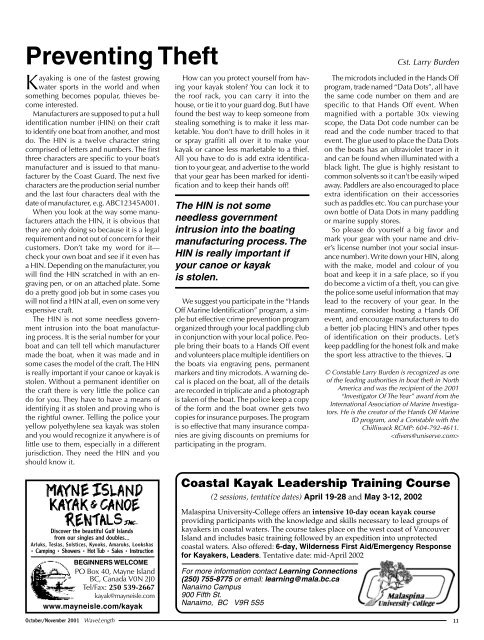Only Ocean Kayaking - WaveLength Paddling Magazine
Only Ocean Kayaking - WaveLength Paddling Magazine
Only Ocean Kayaking - WaveLength Paddling Magazine
Create successful ePaper yourself
Turn your PDF publications into a flip-book with our unique Google optimized e-Paper software.
Preventing Theft<br />
<strong>Kayaking</strong> is one of the fastest growing<br />
water sports in the world and when<br />
something becomes popular, thieves become<br />
interested.<br />
Manufacturers are supposed to put a hull<br />
identification number (HIN) on their craft<br />
to identify one boat from another, and most<br />
do. The HIN is a twelve character string<br />
comprised of letters and numbers. The first<br />
three characters are specific to your boat’s<br />
manufacturer and is issued to that manufacturer<br />
by the Coast Guard. The next five<br />
characters are the production serial number<br />
and the last four characters deal with the<br />
date of manufacturer, e.g. ABC12345A001.<br />
When you look at the way some manufacturers<br />
attach the HIN, it is obvious that<br />
they are only doing so because it is a legal<br />
requirement and not out of concern for their<br />
customers. Don’t take my word for it—<br />
check your own boat and see if it even has<br />
a HIN. Depending on the manufacturer, you<br />
will find the HIN scratched in with an engraving<br />
pen, or on an attached plate. Some<br />
do a pretty good job but in some cases you<br />
will not find a HIN at all, even on some very<br />
expensive craft.<br />
The HIN is not some needless government<br />
intrusion into the boat manufacturing<br />
process. It is the serial number for your<br />
boat and can tell tell which manufacturer<br />
made the boat, when it was made and in<br />
some cases the model of the craft. The HIN<br />
is really important if your canoe or kayak is<br />
stolen. Without a permanent identifier on<br />
the craft there is very little the police can<br />
do for you. They have to have a means of<br />
identifying it as stolen and proving who is<br />
the rightful owner. Telling the police your<br />
yellow polyethylene sea kayak was stolen<br />
and you would recognize it anywhere is of<br />
little use to them, especially in a different<br />
jurisdiction. They need the HIN and you<br />
should know it.<br />
Discover the beautiful Gulf Islands<br />
from our singles and doubles...<br />
Arluks, Teslas, Solstices, Kyooks, Amaruks, Lookshas<br />
• Camping • Showers • Hot Tub • Sales • Instruction<br />
BEGINNERS WELCOME<br />
PO Box 40, Mayne Island<br />
BC, Canada V0N 2J0<br />
Tel/Fax: 250 539-2667<br />
kayak@mayneisle.com<br />
www.mayneisle.com/kayak<br />
October/November 2001 <strong>WaveLength</strong><br />
How can you protect yourself from having<br />
your kayak stolen? You can lock it to<br />
the roof rack, you can carry it into the<br />
house, or tie it to your guard dog. But I have<br />
found the best way to keep someone from<br />
stealing something is to make it less marketable.<br />
You don’t have to drill holes in it<br />
or spray graffiti all over it to make your<br />
kayak or canoe less marketable to a thief.<br />
All you have to do is add extra identification<br />
to your gear, and advertise to the world<br />
that your gear has been marked for identification<br />
and to keep their hands off!<br />
The HIN is not some<br />
needless government<br />
intrusion into the boating<br />
manufacturing process. The<br />
HIN is really important if<br />
your canoe or kayak<br />
is stolen.<br />
We suggest you participate in the “Hands<br />
Off Marine Identification” program, a simple<br />
but effective crime prevention program<br />
organized through your local paddling club<br />
in conjunction with your local police. People<br />
bring their boats to a Hands Off event<br />
and volunteers place multiple identifiers on<br />
the boats via engraving pens, permanent<br />
markers and tiny microdots. A warning decal<br />
is placed on the boat, all of the details<br />
are recorded in triplicate and a photograph<br />
is taken of the boat. The police keep a copy<br />
of the form and the boat owner gets two<br />
copies for insurance purposes. The program<br />
is so effective that many insurance companies<br />
are giving discounts on premiums for<br />
participating in the program.<br />
Cst. Larry Burden<br />
The microdots included in the Hands Off<br />
program, trade named “Data Dots”, all have<br />
the same code number on them and are<br />
specific to that Hands Off event. When<br />
magnified with a portable 30x viewing<br />
scope, the Data Dot code number can be<br />
read and the code number traced to that<br />
event. The glue used to place the Data Dots<br />
on the boats has an ultraviolet tracer in it<br />
and can be found when illuminated with a<br />
black light. The glue is highly resistant to<br />
common solvents so it can’t be easily wiped<br />
away. Paddlers are also encouraged to place<br />
extra identification on their accessories<br />
such as paddles etc. You can purchase your<br />
own bottle of Data Dots in many paddling<br />
or marine supply stores.<br />
So please do yourself a big favor and<br />
mark your gear with your name and driver’s<br />
license number (not your social insurance<br />
number). Write down your HIN, along<br />
with the make, model and colour of you<br />
boat and keep it in a safe place, so if you<br />
do become a victim of a theft, you can give<br />
the police some useful information that may<br />
lead to the recovery of your gear. In the<br />
meantime, consider hosting a Hands Off<br />
event, and encourage manufacturers to do<br />
a better job placing HIN’s and other types<br />
of identification on their products. Let’s<br />
keep paddling for the honest folk and make<br />
the sport less attractive to the thieves. ❏<br />
© Constable Larry Burden is recognized as one<br />
of the leading authorities in boat theft in North<br />
America and was the recipient of the 2001<br />
“Investigator Of The Year” award from the<br />
International Association of Marine Investigators.<br />
He is the creator of the Hands Off Marine<br />
ID program, and a Constable with the<br />
Chilliwack RCMP: 604-792-4611.<br />
<br />
Coastal Kayak Leadership Training Course<br />
(2 sessions, tentative dates) April 19-28 and May 3-12, 2002<br />
Malaspina University-College offers an intensive 10-day ocean kayak course<br />
providing participants with the knowledge and skills necessary to lead groups of<br />
kayakers in coastal waters. The course takes place on the west coast of Vancouver<br />
Island and includes basic training followed by an expedition into unprotected<br />
coastal waters. Also offered: 6-day, Wilderness First Aid/Emergency Response<br />
for Kayakers, Leaders. Tentative date: mid-April 2002<br />
For more information contact Learning Connections<br />
(250) 755-8775 or email: learning@mala.bc.ca<br />
Nanaimo Campus<br />
900 Fifth St.<br />
Nanaimo, BC V9R 5S5<br />
11

















